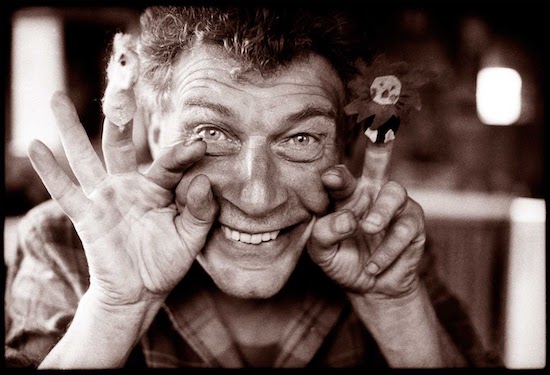In John Berger’s 2005 collection of short stories, Here Is Where We Meet, a collection which might be described as fictionalised memoir and which contains eight, or more precisely 8½, loosely interweaving autobiographical stories, the author’s dead mother relates to him a memory of his childhood self. ‘I never saw anyone look as hard as you did, sitting on the edge of your seat,’ she tells him.
The book offers encounters with the dead and with the living. It is about memory and how those who have departed pop back into the lives of the living in unexpected ways and unexpected places. "The dead don’t stay where they are buried," his mother says, after encountering her son in a square in Lisbon in the opening story.
But it seems above all that, that the book is an encounter with John Berger, or at least with a character he closely resembles, who is simply called John and who appears in tales that are elliptical and episodic and which take place in various European cities which are also bought vividly to life.
And as a summary of Berger’s character, the words he puts into his mother’s mouth, that she ‘never saw anyone look as hard as he did,’ seem now a fitting tribute, for, as an essayist and fiction writer, as an artist (he was a painter first and studiedly drew from life, throughout his long life), as a broadcaster and performer (an actor in collaboration with Simon McBurney as he approached his 80s), as the writer and presenter of the ground-breaking Ways of Seeing, and, earlier, for a time, as an art critic (though he hated the C word, and eventually opted for Storyteller for all these other myriad activities), Berger looked hard and deeply and saw things that radically altered the way we saw them, too. And this claim is not mere hyperbole. There is a before and after Berger.
Who now, informed in visual culture, can look at the Gainsborough painting Mr and Mrs Andrews and not see the pinched features of smug proprietorship in the faces of this languid, softly formed estate owner and his prettily shod wife? A charming scene as described by Civilisation’s Kenneth Clark becomes a series of codes, signs, signifiers, under Berger. And if this sounds dryly reductive, well, yes, it is, or it can be – and that is the criticism most often levelled at Berger. Everything can end up having the same visual value and weight – a Holbein and an advertising poster. Does this matter?
The detractors have a point, of course. But if you’re looking deeply, then layers of information don’t necessary subtract from what we might old-fashionedly call ‘art appreciation’. And it may be worth stating that it’s pretty clear Gainsborough himself was more than aware of class dynamics. How could he not be, as he went about building his clientele, establishing patronage? It’s evident from his letters that all he really wanted to do was paint landscapes and actually deeply resented the pampered and powdered lordships that he ended up having to paint for his coffers. It took him away from what he loved. So what Berger does is not simply wrap us up in class theory; he actually places us in the artist’s shoes. Time and again, in fact. He does it brilliantly with Frans Hals too, who really was down on his uppers in the last years of his life. He’s asking, what was it like to live this experience as a working artist? Context informs our gaze.
‘The relation between what we see and what we know is never settled,’ he wrote in the book that followed on the heels of the four-part BBC series for which (along with James Tait Black Memorial Prize and the Booker Prize money he gave to the Black Panthers) he became famous in 1972. As we’ve seen, it was the things outside the picture that concerned him, namely class, gender, race, power relations, power structures. His was not a study in connoisseurship; he bought Marxism to the forefront of what became known as the study of visual culture. He popularised the theories of Walter Benjamin, particularly the German cultural theorist’s 1930s essay The Work of Art in the Age of Mechanical Reproduction. On TV, he’d shaken us up by taking a knife to Botticelli’s Venus and Mars, cutting out the face of Venus to illustrate with televisual brilliance how reproductions are changing our relationship to the work. It changes, because nothing is ever settled and what we know is forever in a state of flux.
In the last story of Here Is Where We Meet, before the coda, Berger tell us how to shell a boiled egg cleanly, without chunks of gelled egg white sticking to the insides of the shell. It’s just one sentence, but a whole paragraph, which stands on its own.
‘I run the water from the cold water tap over the hard boiled eggs and I roll them between the palms of my hands so that the shells will come off easily.’
I’ve never forgotten this instruction. It’s useful. Rolling the egg breaks the membrane, so you get a perfect uncasing. And I’ve shared the lesson with others. This simple process is described in so measured and precise a way that it struck me then that it captured perfectly the way Berger saw and wrote about the world in his fiction – the incidental and everyday close up in its detail. And it’s also deeply cinematic: like art house cinema, the way the camera’s lens captures a wide shot – some drama, some movement, or conversation – but then focuses on an intensely quiet moment in close-up, like a pause or a meditation.
Also, I think he was simply seduced by the look and feel of an egg in its shell. Looking had that sort of intensity for him.
John Berger’s A Seventh Man, with photography by Jean Mohr, is available from Verso Books


